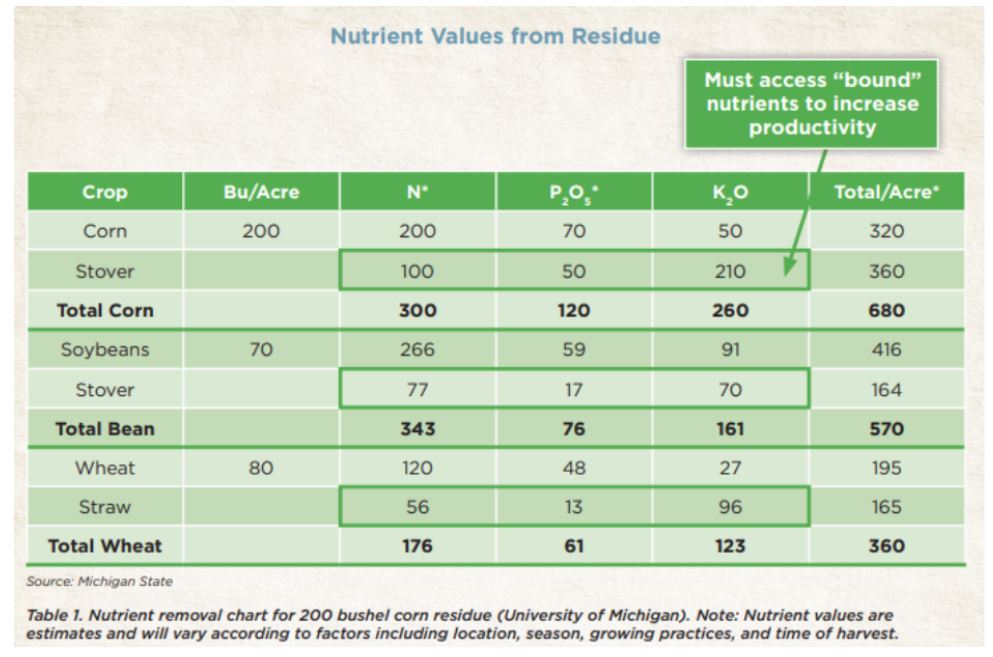
Corn residue is an excellent source of nitrogen, phosphorus, potassium, magnesium, and sulfur. However, those nutrients can stay tied up in stalks if not properly managed.
Following harvest, there is time for one more play before the start of the 2022 season. Your routine lineup likely consists of an herbicide for burndown application. However, don’t leave out the true MVPs – the microbes. These key players are responsible for composting and breaking down residue to improve nutrient availability, reduce planter or tire damage from tough stalks, and enhance seed-to-soil contact in the spring.
Catch a glimpse into this end-of-season challenge and the winning solution to set fields up for success in 2022.
THE CHALLENGE
Stalk residue retains valuable nutrients, but they are locked up and inaccessible by growing crops. Once soil microorganisms break down the residue, critical nutrients are released to the soil and available to the growing crop. This is a natural process that occurs slowly, usually taking around three years to break down corn stalks. When a microbial package is applied, the process of stalk degradation is accelerated, releasing nutrients for next year’s crop. The fertilizer value of crop residue is well-documented and can be easily calculated per ton of stover (Figure 1). The nutrient content of every ton of corn residue can be up to 4 lbs of P2O5, 22 lbs of K2O, and 1 lb of sulfur.
Figure 1: Estimated nutrient removal chart for 200 bu/acre corn residue (Source: University of Michigan).
In addition to holding valuable nutrients, corn stover can also be a host to pathogens for overwintering. The disease triangle consists of three things: a host, a pathogen, and an ideal environment. For a disease to occur, all three aspects of the disease triangle must be present. Corn stover (host) and pathogens comprise two necessary parts of the disease triangle. If we can remove one of these pieces from the disease triangle, a disease cannot occur, Figure 2. By properly managing residue, it is possible to eliminate the host, thereby minimizing the chance of the presence of disease the following spring.

THE WINNING PLAY
Your best ally in the residue battle is right beneath your feet – it is your soil! A healthy soil has an abundance of beneficial microorganisms (microbes) that are ready to get to work degrading the residue your crops have left behind. Years of tillage, along with fertilizer and chemical applications, may have diminished natural microbe populations in your soil.

To reverse the effects of these practices and supplement your microbial populations, The Andersons has launched Bio Reverse™, a new microbial product. Bio Reverse is a robust microbial package designed to significantly reduce residue stubble prior to the next cropping season. The unique, tough and stable formulation has been designed to compost and break down residue to improve seed-to-soil contact, help reduce planter or tire damage from tough crop stalks and reverse nutrient tie-up in crop residue to provide more available nutrients prior to your next season’s planting. Bio Reverse helps build a healthy soil biome for continued season-long composting.
HOW IS BIO REVERSE APPLIED?
Bio Reverse may be applied with fall herbicides, mixed with liquid fertilizers, impregnated on dry fertilizers, included in pivot irrigation, or sprayed with any other carriers that may be applied in the spring or fall.
BIO REVERSE FREQUENTLY ASKED QUESTIONS
Q: When is the best time to apply Bio Reverse to maximize decomposition of crop residues?
A: Apply Bio Reverse as soon as possible following harvest, to allow maximum residue decomposition.
Q: Will the microbes in Bio Reverse survive the cold temperatures endured during the winter?
A: The microbial strains in Bio Reverse will survive the cold temperatures experienced in the winter months. The strains are cold weather-tolerant and will continue to be active until sustained below freezing temperatures are present. During the coldest months, the microbes will become dormant to survive any winter conditions. When the weather begins to warm, the microbes in Bio Reverse will become active again and continue colonizing the crop residue.
Q: How can the microbes be applied to the field and residue?
A: The consortium of microbes in Bio Reverse are in a robust sporulated form that allows for the following application methods: broadcast with fall herbicides, mixed with liquid fertilizers, impregnated on dry fertilizers, pivot irrigation, or sprayed with any other carriers that may be applied in the spring or fall.
Q: How does Bio Reverse break down crop residue?
A: Bio Reverse is a specially selected package of soil borne microbes chosen for their ability to break down the cellulose and lignin in plant tissues. The unique blend of microbes works together to support the production of enzymes needed to break down cell walls and compost residue. Bio Reverse is formulated with a significant volume of colony forming units (CFUs) to ensure excellent coverage for improved performance.
Q: What other benefits would you expect from the composting of residue?
A: When Bio Reverse is applied in the fall, expect better seedbeds the following spring due to improved residue breakdown. The application of Bio Reverse will provide better seed-to-soil contact, helping to improve consistency of seed depth in the field. Another key benefit is the recycling of nutrients from crop residues. Bio Reverse breaks down crop residues post-harvest, making nutrients more available the following season to meet crop needs.
HOW DO I LEARN MORE?
Reach out to your Territory Manager from The Andersons or local authorized dealer to learn more about Bio Reverse. Need to be connected with a local dealer? Contact us.
© 2021 The Andersons logo is a registered trademark of The Andersons, Inc. Bio Reverse is a trademark of The Andersons, Inc.






